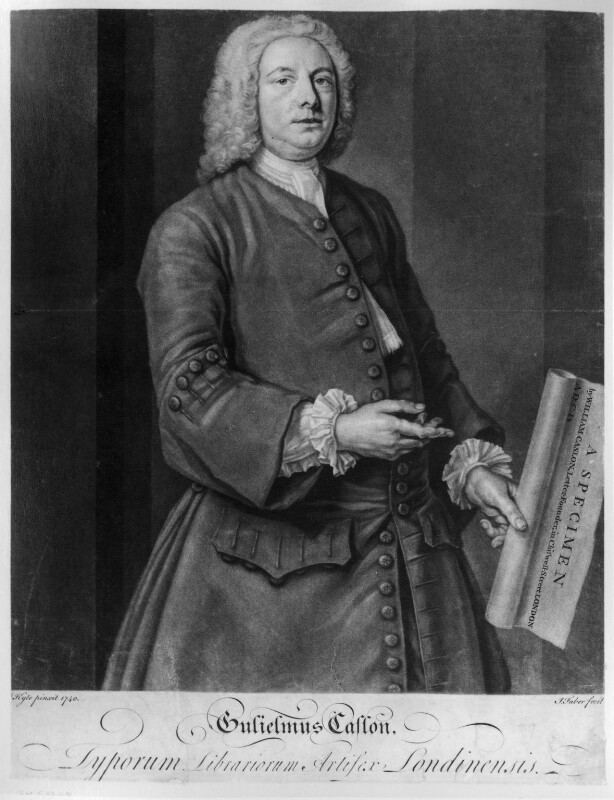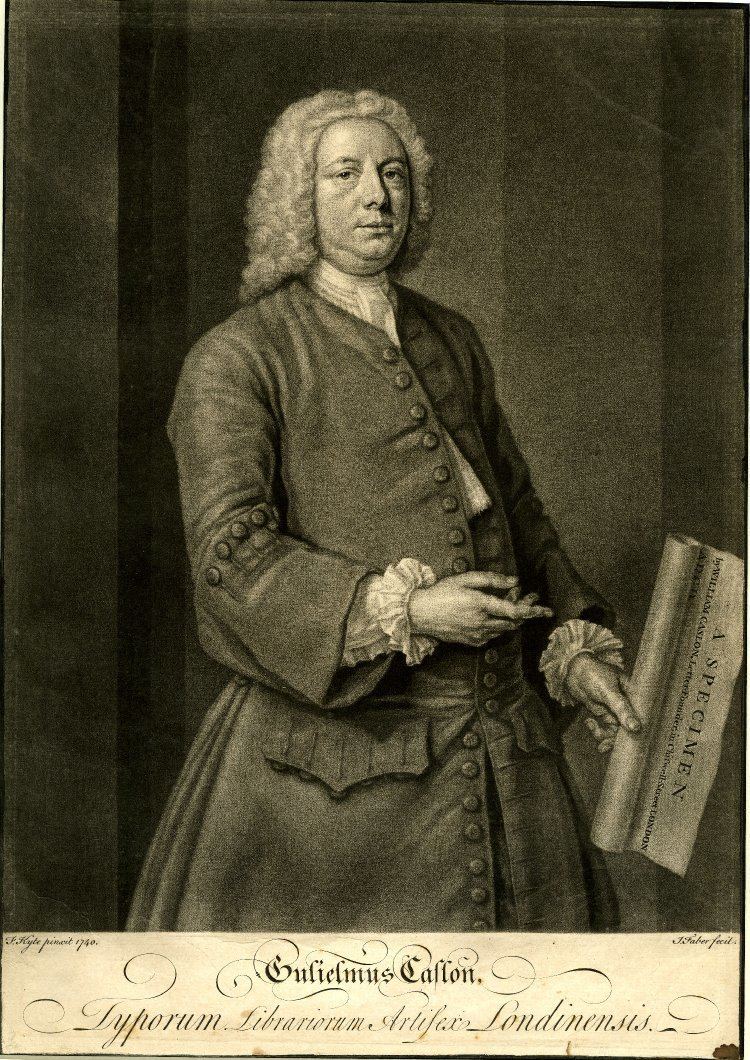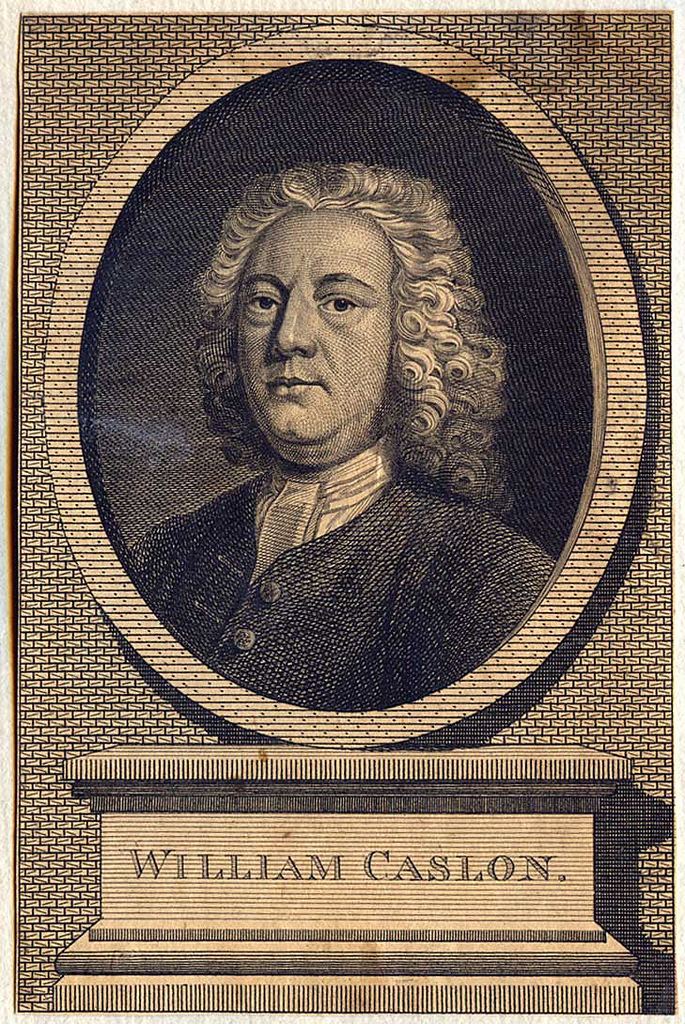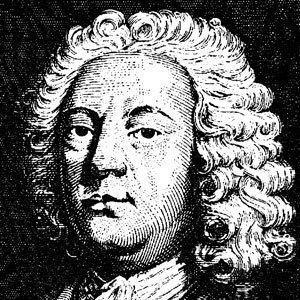Name William Caslon | ||
 | ||
Born 1693 Cradley, Worcestershire Occupation Gunsmith and type designer People also search for John James, Nicholas Hawksmoor, Luke the Evangelist | ||
William caslon british typographer
William Caslon I (1692/1693 – 23 January 1766), also known as William Caslon the elder, was an English gunsmith and designer of typefaces. The distinction and legibility of his type secured him the patronage of the leading printers of the day in England and on the continent. His typefaces transformed English type design and first established an English national typographic style.
Contents
- William caslon british typographer
- William caslon
- Life
- Typefaces
- Caslon Foundry
- H W Caslon and Company Limited
- References

William caslon
Life

Caslon was born in Cradley, Worcestershire, in 1692 or 1693 and trained as an engraver in nearby Birmingham. In 1716 he started business in London as an engraver of gun locks and barrels, and as a bookbinder's tool cutter. Having contact with printers, he was induced to fit up a type foundry, largely through the encouragement of William Bowyer.

He died on 23 January 1766, and was buried in the churchyard of St Luke Old Street, London, where the family tomb (bearing his name and others) is preserved.
Typefaces

Caslon's typefaces were inspired by the Dutch Baroque types, the most commonly used types in England before Caslon's faces. His designs influenced John Baskerville and are thus the progenitors of the transitional and Didone typeface classifications.

Caslon typefaces were immediately popular and used for many important printed works, including the first printed version of the United States Declaration of Independence. Caslon's types became so popular that the expression about typeface choice, "when in doubt, use Caslon," came about. The Caslon types fell out of favour in the century after his death, but were revived in the 1840s. Several revivals of the Caslon types are widely used today.
Caslon Foundry

William Caslon founded the Caslon Foundryell's Foundry in 1739 (previously Godfrey Head's 1685–1700). The other half was purchased by John James, son of Thomas James. John James also purchased at around 1716–1764, which became the leading English typefoundry of the 18th and early 19th centuries. He acquired moiety of half of Robert Mitch Jacob Ilive in 1840 and later an important purchase was the foundry of Thomas Grover in 1758 - ultimately combining under his direction nine old English Foundries (according to Talbot Reed's "The Old English letter Foundries"). John James, William Caslon I and Baskerville as the only three representatives of the trade in the country. William Caslon I had two apprentices in his Sheffield Foundry, Thomas Cottrell and Joseph Jackson. They started a foundry of their own in direct competition to their employer in 1757. In 1759 Jackson entered the Navy leaving Cottrell to carry on alone. Jackson left the navy in 1763 and continued to be employed in Thomas Cottrell, Neveil's court 1759–1785 Foundry for a short time. He commenced business in a separate Foundry with two fellow workman who helped to find the capital 1764 – 1792. When Jackson died in 1792 it was William Caslon I's grandson, William Caslon III who purchased the foundry in Salisbury Square.
After the death of William Caslon I, his son William Caslon II took over the Caslon Foundry business 1764–1778. In 1792, William Caslon III sold his share of Caslon Foundry to his mother and his sister-in-law, the widow of his brother Henry. Mrs William Caslon II and Mrs Henry Caslon continued to run the original main Caslon business. In the same year, William Caslon III purchased the Salisbury Square foundry from the estate of the recently deceased Joseph Jackson, and renamed it to W Caslon & Son. In 1807, W Caslon & Son was passed to William Caslon IV. In 1819, William Caslon IV sold Caslon & Son to the new Sheffield foundry of Blake, Garnett & Co. In 1837, the Salisbury Square Caslon Foundry became the property of Stephenson, Blake & Co. The main Caslon Foundry was still running. In 1795 the company proprietors were Mrs Henry Caslon & Nathaniel Catherwood 1795–1821; Henry Caslon II & F. F. Catherwood 1809–1821; Henry Caslon II H. W. Caslon M. W. Livermore (Caslon, Son, and Livermore) 1821–1840; Caslon & son 1840–1850; H. W. Caslon and co. 1850–1873 when H. W. Caslon died and the Foundry was acquired by T. W. Smith and partners—the Company name remained. H. W. Caslon and Co., Ltd continued running until 1937, when Stephenson Blake acquired the remaining H. W. Caslon & Sons foundry.
H. W. Caslon and Company Limited
In 1998, Justin Howes reestablished the Caslon foundry, under the name H. W. Caslon & Company Limited, with an expanded version of ITC Founder's Caslon as the company's initial product. However, following the death of Justin Howes in 2005, the revived H. W. Caslon & Company was no longer in business, and the expanded Founders Caslon is no longer offered in the retail market.
